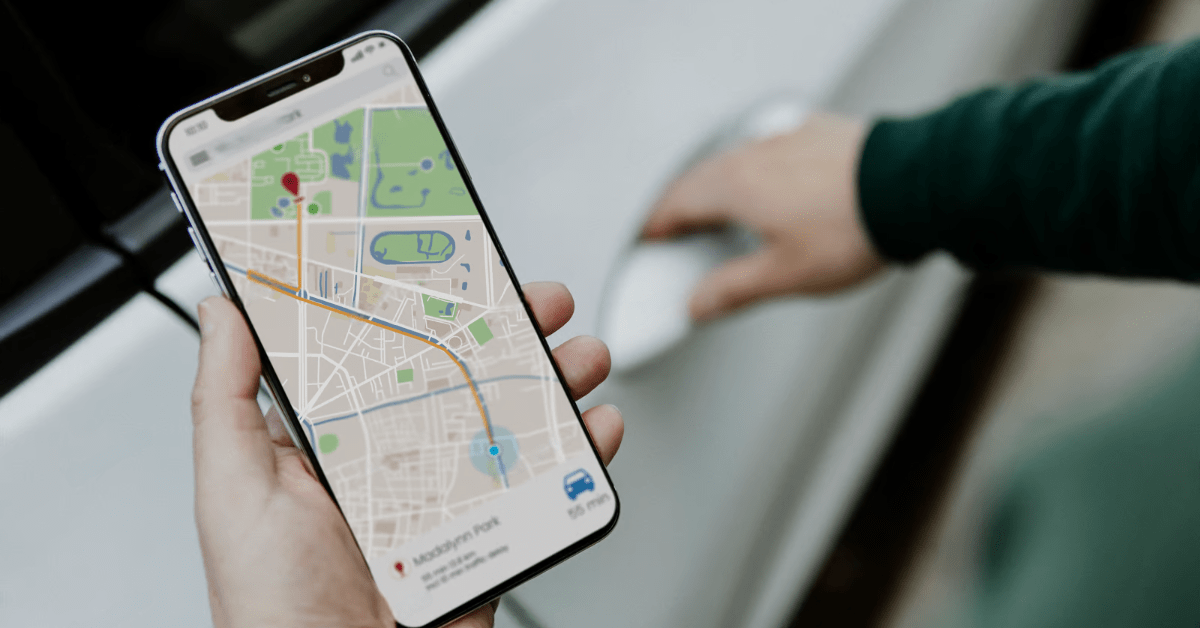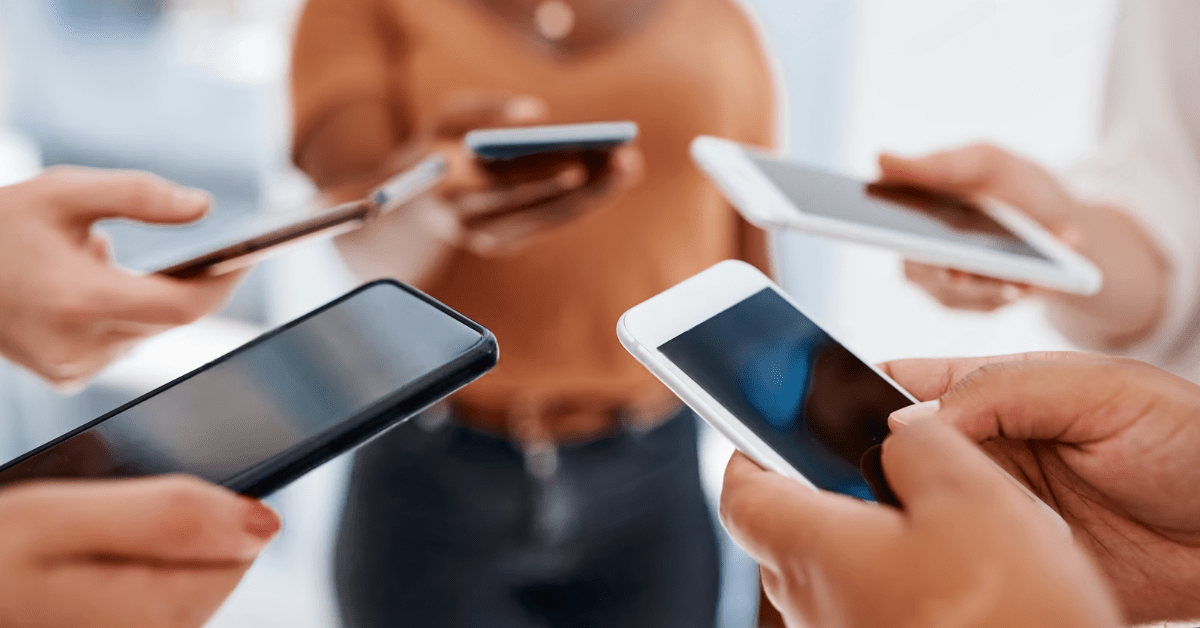
How do mobile networks work?
Mobile networks work through a complex system that involves base stations transmitting radio waves within a hexagonal area – known as a ‘cell’ (hence mobiles also being known as cellular phones). Thousands of cells overlap across geographical areas, aiming to eliminate any areas without signal – if you were ever out of range of a cell, you’d have no signal whatsoever on your phone. These cells are able to send and receive transmitted data and information, picking up and delivering communications between mobiles.
Related blog: How To Check If My Phone Is Unlocked
What is the difference between H+, LTE, 3G, 4G and 5G?
You’ve probably noticed that, next to your signal strength indicator on your phone, sometimes the letters and symbols have changed – along with the speed of your internet. This is because there's a range of mobile networks available from GPRS to 5G, and you’re only able to access each network in certain places. See below what these network symbols mean and how this affects how well your phone performs.
- GPRS - GPRS (Global Packet Radio Service) was the first widely used network connection accessed by mobile phones using GSM, which stands for Global System for Mobile Communications - the system a SIM card uses to connect to a digital mobile network. When you’re connected to this network, you’ll see the G symbol next to your network bars. It’s the slowest of all networks – your phone will only use GPRS as a last resort, so you probably won’t see the G symbol often. It’s used for WAP (internet browsing) and MMS (multimedia messaging, such as sending pictures or videos over text) and typically reaches speeds around 40 Kbit/s. Although, in theory, GPRS could reach up to 115 Kbit/s, it’s unlikely it would ever exceed 50 Kbit/s at most, meaning you wouldn’t be able to use internet data with this network, and would likely struggle to send texts quickly or have a quality phone call.
- E - You’ll see the E symbol when your phone is using Enhanced Data Rates for GSM Evolution, which is also known as Enhanced GPRS. This is the second slowest mobile network, and it’s usually the last network a modern smartphone will connect to. You’ll typically see speeds around 400 Kbit/s, which is significantly faster than GPRS but still isn’t fast enough to browse the internet. Texts will send slightly quicker and calls are more likely to connect though.
- 3G - 3G simply means 3rd Generation. It’s faster than mobile connections before it and uses UMTS, which stands for Universal Mobile Telecommunications Service – it’s the third-generation mobile cellular system for mobile networks based on GSM technology. 3G runs from 384 Kbit/s to 42 Mbit/s (42,000 Kbit/s). Depending on the strength of your signal, you should be able to use the internet quite easily, it may just be a little slow at times. Many smartphones access this network, especially when faster or newer networks aren’t available in the immediate vicinity.
- H/H+ - Your device is using High Speed Packet Access when you see the H symbol. This is still a very common network and most smartphones connect to it regularly when newer networks aren’t available. You should be able to browse the internet and stream audio/video on this network, without many issues, thanks to its 7 Mbit/s speed. Texts and calls will usually be fine, but you probably won’t be able to download a film or any large file in a reasonable amount of time. However, H continued to evolve, becoming H+. H+ can usually provide really decent speeds of up to an impressive 168 Mbit/s – a big improvement from the original H speeds. Using H+, you’ll probably be able to use your phone as normal in terms of internet, text and call usage – you just might notice the speed is slightly slower than 4G.
- 4G/LTE - The 4th Generation of mobile technology, or 4G, uses Long Term Evolution (LTE), which is the upgraded version of UMTS. As of now – before 5G is widely rolled out – it’s the best network your phone can use. With speeds of up to 1 Gbit/s, this network allows your mobile internet to function just as quickly – if not quicker in some cases – than Wi-Fi. You typically won’t have any problems surfing the web, streaming videos in high definition (HD), or downloading and uploading data at any point.
- 5G - 5G, or fifth-generation cellular network technology, is the latest advancement in mobile communication systems. It is designed to provide faster data speeds, lower latency, and more reliable connections compared to its predecessors, such as 4G, 3G, and 2G. Here's an overview of 5G and its main differences from older technologies:
- Speed: 5G offers significantly faster data speeds than previous generations. While 4G networks can achieve speeds of up to 100 Mbps, 5G can theoretically reach speeds of up to 20 Gbps, allowing for near-instant downloads and seamless streaming of high-quality content.
- Latency: Latency refers to the time it takes for data to travel from the source to its destination. 5G has much lower latency compared to older technologies, with a potential latency of less than 1 millisecond. This enables real-time communication and opens up possibilities for new applications, such as remote surgery and autonomous vehicles.
- Capacity: 5G can support a much higher number of connected devices per square kilometer compared to 4G. This increased capacity is crucial in the era of the Internet of Things (IoT), where billions of devices are expected to be connected to the internet.
- Spectrum: 5G operates on a wider range of radio frequencies than previous generations. It utilizes high-frequency millimeter waves, mid-band frequencies, and low-band frequencies, allowing for better coverage and penetration in various environments.
- Network Slicing: 5G enables network slicing, which allows mobile network operators to create multiple virtual networks on top of a single physical network infrastructure. This means that different types of traffic, such as mobile broadband, IoT, and mission-critical applications, can be allocated dedicated resources and tailored to their specific needs.
- Enhanced Mobile Broadband (eMBB): 5G's eMBB feature provides improved user experiences for data-intensive applications, such as high-resolution video streaming, cloud gaming, and virtual reality.
- Massive Machine-Type Communications (mMTC): 5G's mMTC capability enables the efficient connection of a large number of IoT devices, such as sensors and smart meters, with low power consumption and cost.
- Ultra-Reliable Low-Latency Communications (URLLC): 5G's URLLC feature is designed to support mission-critical applications that require extremely low latency and high reliability, such as autonomous vehicles, industrial automation, and remote healthcare.
How do phones affect the signal strength I receive?
Your device can hugely affect the signal strength you have access to and this is due to a number of factors. If you struggle to gain signal consistently – even in areas that have high mobile network coverage – consider the following:
Age:
Of course, the newer your phone is, the better signal it will receive. Phones are manufactured with improved chipsets and antennas to keep up with mobile network developments. For example, if you bought your current device before 4G was rolled out, it’s unlikely that your phone will support LTE networks, meaning it won’t be able to access them at all.
Software:
Your phone's ability to maintain a good signal connection can sometimes be affected by out of date software. Make sure your device is fully updated and is running with the latest software available.
Damage:
If your phone is damaged in any way, it’s possible this damage is creating an interference with your network connection – or worse yet, the antenna itself may be damaged.
Antenna:
If none of the prior points are applicable to you, check nothing is interfering with your antenna’s ability to connect to mobile networks. For example, if you’ve used any kind of phone case that’s not explicitly recommended by your phone manufacturer, it could be interfering with your antenna.
Related blog: How To Stop Your Phone From Overheating
Conclusion:
If you’re looking to upgrade your phone, head over to our search page to view the latest devices which include iPhones, Samsung’s, Huawei’s and HTC’s. If you need any more information or help with making a purchase, visit our advice hub or get in touch – we’re always happy to help!
More articles

Find My iPhone Alternatives
by Charlotte Bolton | updated Apr 01, 2025
With the weather getting warmer and the nights getting lighter… summer is just around the corner! ... READ MORE >

Choosing Between iPhone Mini, Standard, Plus and Pro
by Charlotte Bolton | updated Mar 12, 2025
Over the years, Apple has created a lot of products, their Smartwatches, MacBooks, Apple TVs, iPads and of course the classic iPhone range. ... READ MORE >

Should I Buy The iPhone 11 In 2025?
by Charlotte Bolton | updated Feb 18, 2025
Each year, Apple releases its new, iconic iPhone with bigger specs and better design features than the last.... READ MORE >

